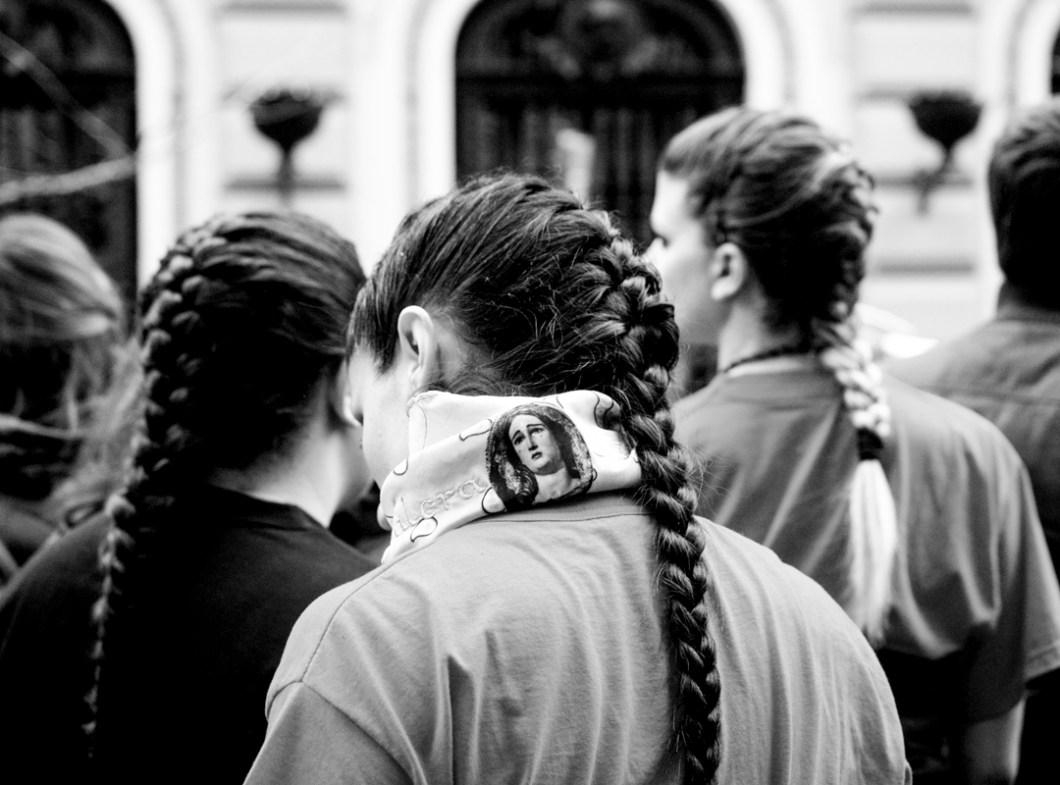
Semana Santa
[vc_row row_type=”row” use_row_as_full_screen_section=”no” type=”full_width” text_align=”left” css_animation=””][vc_column][vc_column_text]
[dropcap]Semana[/dropcap] Santa (Holy week) is upon us in Spain (starting the 13th of April) in the context of austerity, massive demonstrations, repression, media censorship, strikes and discontent. With Spain reaching 4.8 million unemployed in February, and 54.6% youth (under 25yrs) unemployment: the country is broken. This data collides with the extravagance of Semana Santa, costing city councils and local governments more than 5 million euros, for this reason alone Semana Santa is surrounded by polemic and criticism.Spain has a deep-rooted catholic tradition and this is specifically apparent during Semana Santa.
Semana Santa is the celebration and commemoration of the Passion, Death and Resurrection of Jesus of Nazareth. During this season, there are acts of religiosity all around the country that are also a cultural-touristic attraction, mobilising a large amount of visitors and tourists every year.
Although a secular state 78% of Spanish people consider themselves Catholic with 18% being practicing Catholics, however many Spaniards don’t feel represented by the Church. This misrepresentation is less about ones faith and more about the history & privileges of the Catholic Church in Spain (even if the country is considered confessional in its Constitution), which annually receives more than 12 million euros from the Government. In a delicate moment where 21.6% of the population lives in complete poverty.



Another of the main criticisms against these Parades known as “Procesiones” is the representation of women: chastity, sorrow, and submission. Do Spanish women feel represented by these images? During my documentation of Semana Santa I specifically focused on the contrast between the women and men; the discrepancies in the roles they play.
With a new abortion law enacted in Spain, women are fighting for the decriminalisation of their bodies, yet Semana Santa shows women in their traditional roles, with subtle connotations of the Church controlling their bodies and their place in society.
The Spanish government is eager to enforce a law banning demonstrations and to criminalise protesters. These protesters are on the streets, demonstrating against the government, and the austerity measures. However the same government that is making cuts to education and schooling is spending huge sums of money for Catholic celebrations, a example of the disconnect between politicians and the public, and shows the strength of the relationship between the Church and State.
Faith can be beautiful, some of these images show this. Semana Santa is a impressive spectacle that can create strong community bonds, but it also shows (or hides) a huge power structure, bringing to many people echoes of a past ideology, which seems to be making its way back into our society.
La Semana Santa está a punto de empezar en España (a partir del 13 de abril) en un contexto de austeridad, manifestaciones masivas, represión, censura mediática, huelgas y descontento. Con la cifra de parados llegando a los 4.8 millones y el porcentaje de paro juvenil (de menores de 25 años) llegando al 54.6%, el país está ahogado.



Estos datos chocan con la extravagancia de la Semana Santa, que cuesta a algunos ayuntamientos más de 5 millones de euros y esa es una de las razones por las que este periodo está rodeado de críticas y polémica.
España tiene una tradición católica muy enraizada, especialmente visible durante la Semana Santa y en especial en la región de Andalucía donde las celebraciones son más espectaculares y con más participación.
Semana Santa es la celebración y conmemoración de la Pasión, Muerte y Resurrección de Jesús de Nazaret. En esta temporada, se dan actos de religiosidad en todo el país que son también una atracción cultural y turística que moviliza una gran cantidad de visitantes y turistas cada año.
Aunque España es un estado aconfesional según la Constitución, en el que el 78% se considera Católico aunque sólo un 18% reconoce ser practicante. Sin embargo, muchos españoles y españolas no se sienten representados por la Iglesia ni por las celebraciones de Semana Santa. Esta falta de representación no es tanto una cuestión de fe como de historia y de privilegios de la Iglesia Católica, que recibe más de 12 millones de euros del Estado cada año, en un delicado momento en el que el 21’6% de la población, según los medios, vive por debajo del umbral de la pobreza.
Otra de las grandes críticas en contra de las Procesiones de Semana Santa es la representación de la mujer: castidad, pena, sumisión. Se sienten las mujeres españolas representadas por esta imagen? Durante mi documentación fotográfica de la Semana Santa me centré especialmente en el rol que juega la mujer.
Con una nueva y restrictiva ley del aborto propuesta en España, después de largo tiempo de lucha feminista contra la descriminalización del cuerpo femenino, la Semana Santa muestra las mujeres en roles tradicionales y con connotaciones de la Iglesia controlando sus cuerpos y su lugar en la sociedad.
Además, el gobierno español ha lanzado una propuesta de ley que prohibiría las manifestaciones y criminalizaría los manifestantes, mientras durante la Semana Santa se paralizan y cortan calles para habilitarlas para los pasos y las Procesiones. El mismo gobierno que recorta en educación y salud pública gasta millones de euros para celebraciones Católicas, dando el ejemplo de la desconexión existente entre políticos y ciudadanos y la estrecha relación entre Iglesia y Estado.
La fe es un hermoso sentimiento, y estas imágenes lo muestran. La Semana Santa es un espectáculo impresionante que crea fuertes lazos de comunidad pero también esconde (o muestra) una gran estructura de poder que trae a muchas personas ecos de una ideología pasada, que sin embargo parece estar de vuelta en nuestra sociedad.
Anna Sans
Anna is a documentary photographer and urban anthropologist, based in Granada, Spain.
[/vc_column_text][/vc_column][/vc_row]











